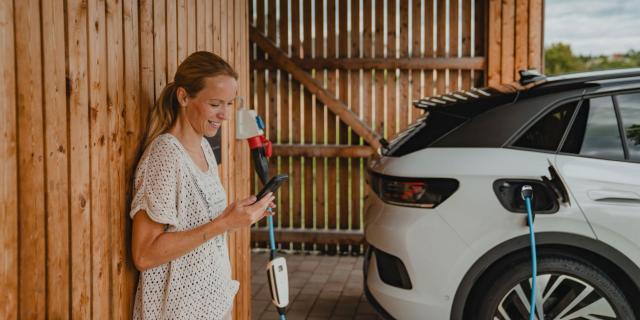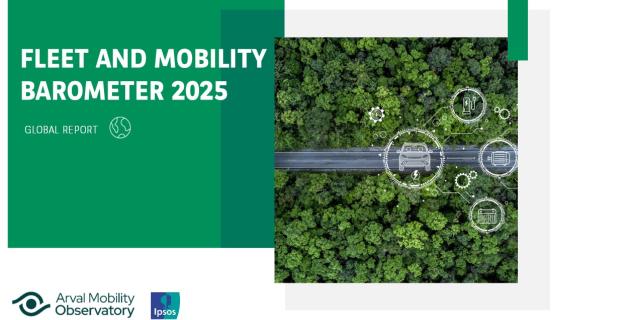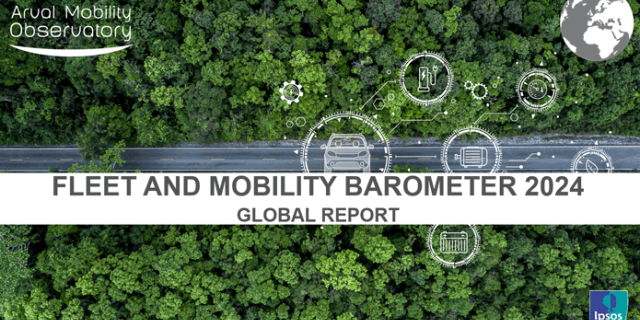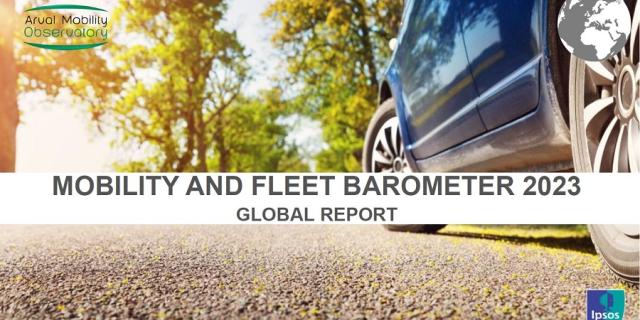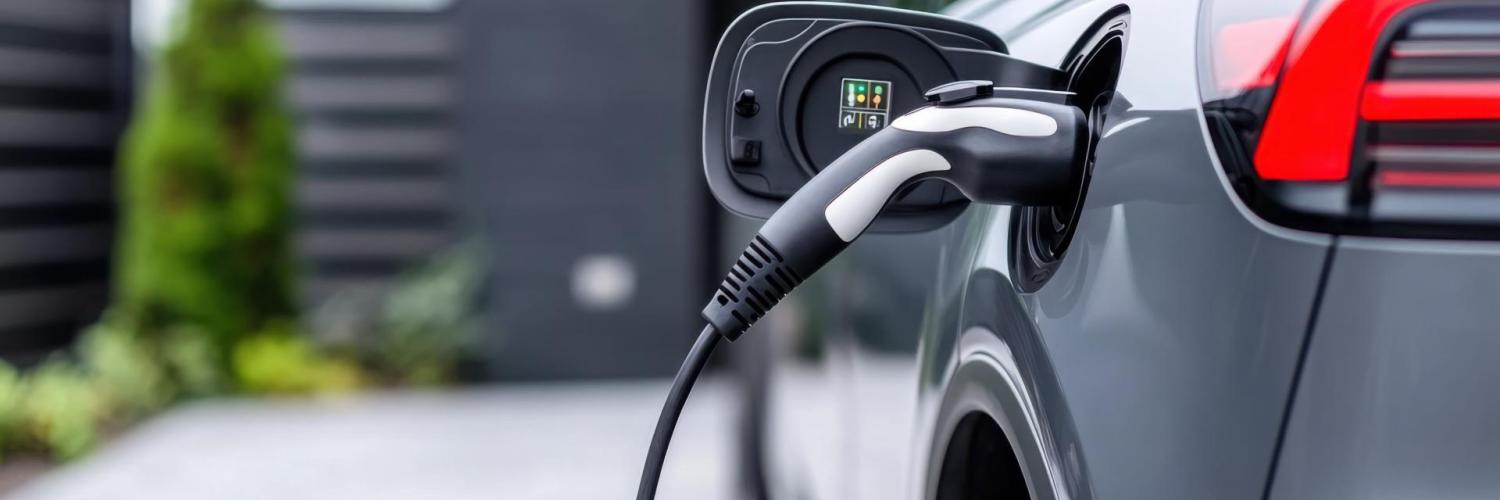Battery electric vehicles (BEVs) and plug-in electric vehicles (PHEVs) continue to be in high demand in the EU, accounting for 15.3% and 7.9% of new car registrations for the period of January to April 2025.
However, the future of EVs depends not only on their ability to satisfy range requirements and other operational needs, but also on charging and grid infrastructure, and whether it can meet the demands of fleet managers and private owners.
In the Netherlands, for example, grid capacity is a growing concern for many, including ex-Minister for Climate and Energy Policy, Rob Jetten, whose main preoccupation looking at 2030-2035 emission goals was the congestion of grid infrastructure related to EV use. The Dutch grid operator has already advised electric car charging station operators to suspend services between 4 p.m. and 9 p.m.
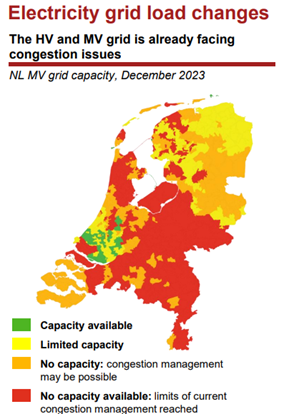
The Netherlands’ power grid has reached its current congestion management capabilities in a large part of the country (Source: Strategy&)
Thankfully, there are ways to tackle increasing demands on power grids, such as smart charging, vehicle-to-grid (V2G) charging and vehicle-to-everything (V2X) charging. In this article, we’ll look into each of those technologies, potential use cases, and their usefulness for fleet operators and car owners.
Smart charging: The next step in efficiency
With smart charging, electric vehicles (EVs), charging stations, and the grid exchange data to optimize the time and speed of charging, based on electricity prices, grid demand, and user needs. This enables users to adjust their charging patterns and favor times of low demand or high renewable energy availability.
Smart charging uses three main methods in which EVs can help improve grid flexibility:
- Controlled charging (V1G), or “unidirectional smart charging”, involves adjusting EV charging schedules to align with grid needs, for example by delaying charging to off-peak times to reduce grid stress
- Vehicle-to-Grid (V2G) transforms EV batteries into active grid resources, where they could charge during periods of excess supply and, when needed, discharge power back to the grid to help meet demand.
- Vehicle-to-Everything (V2X) allows EV batteries to supply power not only to the grid but also directly to homes, businesses, or other infrastructure as needed – for example in emergencies or to reduce dependency on the grid during peak hours
For fleets, smart charging can reduce operational costs by enabling off-peak charging, enhance load management by preventing power spikes, and mitigate risks of grid overloading. It also enables fleet operators to better meet their sustainability targets by charging fleets during times when renewable energy is more readily available.
For employees, smart charging might help reduce electricity bills by scheduling charges during low-rate periods – and allow a better use of renewables, reducing personal carbon footprints.
Controlled charging for better grid capacity management
According to Strategy&, a subsidiary of PwC, by using controlled charging alone, it’s possible to operate six times as many charging stations on a single transformer without exceeding its peak capacity.
Controlled charging is gaining traction in several countries. In the Netherlands, for example, the Dutch National Charging Infrastructure Agenda has set out to build an action program called “Smart charging for everyone”, which aims to provide smart charging to users and roll out grid friendly charging at a national level by 2025.
The Danish company E.ON, owned by E.ON Sverige AB, incentivizes charging during off-hours with the help of dynamic pricing, which can offer substantial cost savings to users during off-peak hours.
In the US, managers of federal fleets are encouraged to transition to use smart charge management (SCM) where they schedule charging sessions during off-peak hours to reduce operating costs.
Providers that are testing or have already deployed smart charging initiatives include DREEV (backed by EDF), ChargePoint, Siemens, and more.
Vehicle-to-Grid (V2G): Turning EVs into energy assets
Vehicle-to-grid (V2G) charging, or bi-directional charging, enables EVs to return excess energy to the grid, stabilizing it during peak demand periods.

Vehicle-to-grid charging would enable the vehicle to return energy to the power grid (Arval Mobility Observatory)
Overall, V2G is still an emerging technology, with different companies exploring the potential of energy sharing between EV fleets and local grids to improve resilience, or implementing pilot programs. For example:
- EDF and NUVVE have partnered to create DREEV, a joint venture that focuses on developing V2G technology that will enable EV owners to sell surplus electricity back to the grid
- The Danish “Parker Project”, a smart charging pilot program dating back to 2019, demonstrated how EVs can provide grid services through bidirectional V2G charging
- Nissan aims to implement affordable bi-directional charging solutions by 2026
- Nuuve, a company developing vehicle-to-grid (V2G) software technology, has launched multiple pilot projects in different countries, such as the UK, Spain, Denmark, and more
- Renault is developing its Mobilize V2G service, which will be implemented in its future Renault 5 electric vehicle which allows owners to reduce costs by selling electricity back to the grid
V2G technology faces a number of challenges which require a strong involvement and targeted actions from governments and industry actors. Here are some examples of ways to tackle existing problems:
- The implementation of harmonized standards for different EVs, chargers, and grid systems, which would guarantee interoperability
- Strong regulatory and policy support from governments, including avoiding the double taxation for charging
- The progressive reduction of the costs of bidirectional chargers, as the technology matures
- Addressing users’ concerns related to battery degradation due to frequent charging and discharging
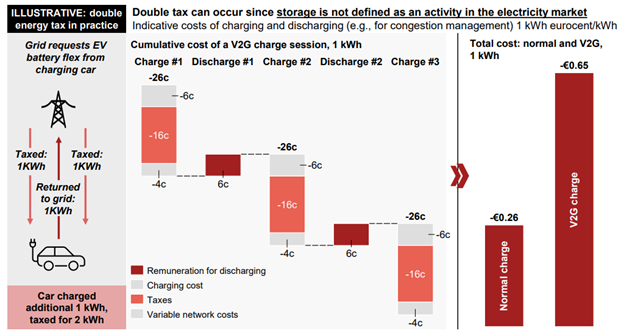
If they want to support V2G charging, governments need to address double taxation issues (Source: Strategy&)
As for the benefits for fleets, V2G could help reduce costs and even provide potential revenue generation opportunities in the future by charging during off-peak hours and selling surplus energy back to the grid. For example, in the UK, a NHS Trust in Manchester managed to reduce its energy bills and the carbon footprint of hospitals.
In the future, V2G could also improve fleet resilience and energy efficiency by creating a mobile energy storage system – or also support grid stability during high-demand periods.
Additionally, employees can save on charging costs and contribute to the company’s overall ESG goals.
Vehicle-to-Everything (V2X): Expanding the role of EVs
Vehicle-to-Everything (V2X) is an extension of Vehicle-to-Grid (V2G) technology, connecting EVs not only to the grid but also to other entities and infrastructures, such as:
- Homes (Vehicle-to-Home, V2H)
- Buildings (Vehicle-to-Building, V2B)
- Other vehicles or traffic systems
Currently, V2X technology is in its early stages, with ongoing research and pilot projects aimed at testing its feasibility and scalability. Examples include:
- Pacific Gas and Electric Company (PG&E)’s Vehicle-to-Everything (V2X) pilot program in California, where customers could use their vehicles to power their property temporarily during outages, adapt charging patterns to grid demand and prices, and earn additional incentives
- “V2X Suisse”, a Swiss V2X project at Bern’s train station parking, which aims to explore how EVs can be used as energy storage units in the future
- Japanese car manufacturer Nissan, whose Nissan Leaf model has V2X capabilities
Here, it’s important to mention that V2L (Vehicle-to-Load) technology already exists; this is a precursor to V2X that enables EVs to directly power external devices or appliances and some OEMs offer this feature (for example, BYD).
In the future, V2X could optimize commercial fleet operations by enabling EVs to serve as power sources for work sites, either to reduce downtime or serve as mobile power sources for off-grid sites. Businesses and employees could use V2B and V2H capabilities to power offices and homes during peak hours and reduce energy costs.
In emergencies and in disaster-prone areas, fleets could also temporarily power essential equipment or be used as mobile power sources.
However, widespread V2X adoption will require major advances in communication, charging protocols, and infrastructure that enable sharing data and electricity among EVs, buildings, and traffic systems.
New charging technologies are currently under development – but could offer significant advantages to grid operators, fleet managers, and car owners
Smart charging, V2G, V2L, and V2X have the potential to redefine how the energy required by electric vehicles is managed, consumed, and stored:
- Grid operators could reduce and level the highest peaks of energy consumption, stabilizing the grid and ensuring it can meet the demands of the local population and businesses.
- Fleet managers could, in the future, reduce costs and improve the operational efficiency not only of their fleet, but also of remote off-grid sites, which otherwise rely on diesel generators.
- Employees could benefit from more convenient and affordable access to electricity for their homes – and reduce their personal carbon footprint
Smart charging is already gaining adoption through various solutions, such as advanced wallboxes and connected vehicles, while V2G and V2X technologies are progressively improving. Those developments offer immense potential and could change the way we use EVs, potentially positioning them as a mode of transportation and a mobile energy resource in the future.
This could transform EVs into an essential part of energy ecosystems – and offer many potential benefits to all actors, from energy suppliers, to companies operating EV fleets, and to individual drivers.




